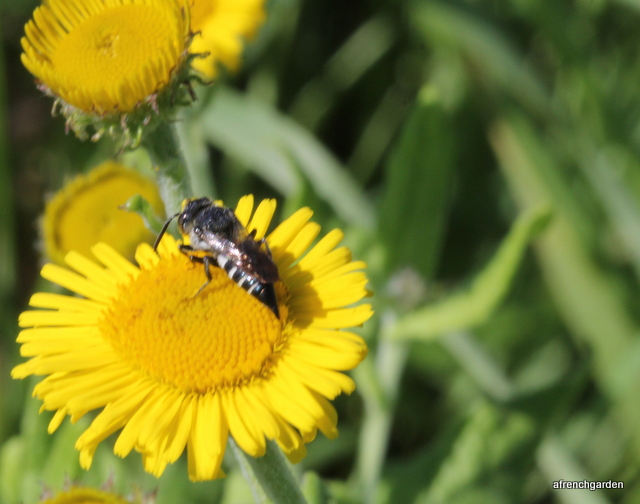Just as the cuckoo lays its eggs to be hatched in another birds nest, cuckoo bees lay their eggs in other bees nests. The story continues in a similar manner with the larval cuckoo bee consuming the host egg/larva and the food supply laid down for its growth by the host bee.
I had read about the cuckoo bees but had not seen any until this year. That changed at the end of May this year when I noticed a Melecta albifrons on the Nepeta in the garden. The Nepeta is still flowering and attracting bees even in late September and at the beginning of the year it attracts plenty of Anthophora. M. albifrons is a parasite of Anthophora plumipes but I have never seen any Melecta near their nests in our stone walls. There is also a possibility that these are Melecta lucosa which parasitise other Anthophora but I cannot differentiate between them from the photographs. I am surprised that I have not seen more Melecta as I often watch the different Anthophora in the Nepeta and the Lavender when it is in bloom.
It was in the lavender in the garden at the beginning of July that I spotted the next cuckoo. I have only the genus here – Thyreus, as there are several species in France.
It looks similar to images of Thyreus histrionicus that I have seen.
This year I have been looking at the bees on the Common Fleabane (Pulicaria dysenterica) and at the end of September I saw another Thyreus.
They are quite large bees but fast movers so I did not get as many shots as I would have liked. It looked very similar to the bee I had seen earlier in the year but I cannot comment on the species. These flowers are visited by Megachiles so they would provide a good meeting place as well as a nectar feed.
I’d really like to be able to identify the bees to species level but this is not usually possible from a shot on a flower but it is usually possible to find the genus. However, the above image taken on the 15 September 2014 has me stumped.
It may be a Thyreus but I cannot find any similar on the web. I can find little information on the hosts, probably generally the Anthophorini. We have Amegilla here in the summer which is a possible host but it may also use the Anthophora.
As soon as I saw this shape I knew it was unmistakeably, Coelioxys, perhaps Coelioxys elongata. These bees are related to the Megachiles whose nests they will lay their eggs in. They will also use nests of the Anthophora such as Anthophora furcata which nests in wood like the Megachiles.
Watching the Common Fleabane (Pulicaria dysenterica) has proved a very interesting exercise and I found more species than I had expected. They attract a great variety of bees and it has helped to push my IDs to over twenty now.










Lovely post. Really interesting and as always great shots. I’m sorry I can’t help with the one that you cannot identify…. 🙂
LikeLike
Thank you but if you ever see a picture of a funny bee you you know who would like to hear about it. Amelia
LikeLike
I find this concept of usually hard working bees who aren’t hard working at all but steal from other bees really interesting. the mechanism for evolving in this way must be quite complicated don’t you think? You are becoming a real expert on your bees. Have you always been interested in them or only since you moved to France?
LikeLike
I first became interested in France when my husband found something looking at him from a hole in the stone wall on the outside of our house. It was very strange and we had no idea what it was. I found out it was a solitary bee, Anthophora plumipes, and that was that – hooked!
The evolution of parasitism is very interesting. Queen bumble bees have been known to sneak into another queen’s nest and lay eggs there, perhaps if she was having difficulty finding a good nest site. So parasitism could evolve in this way, the cuckoo bees are often closely related to the bee they parasitise, It is suggested that Thyreus is derived from Amegilla-like ancestors and Melecta from Anthophora-like ancestors. Amelia
LikeLike
Oh! That is really interesting, I suppose most things start almost by accident and then slowly it became a learned trait.
LikeLike
I think your mystery bee is going to turn out to be a male Coelioxys or Anthidium sp.
LikeLike
I think you are correct. It is such a strange one I think it is most likely to be a male. Amelia
LikeLike
I’ve never seen – maybe I mean noticed – these bees, but next year I’ll keep a look out for them. Nepeta. We have that. I assume this species exists in southern UK (must look it up next…). RH
LikeLike
Here my Nepeta keeps on flowering until it gets really cold and it is flowering in time to catch all the early bees. I’m sure it will be good in the south of England.
LikeLike